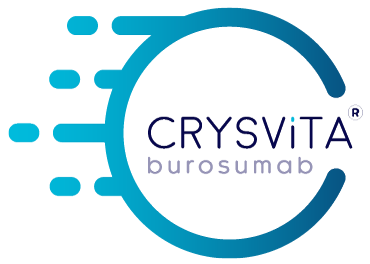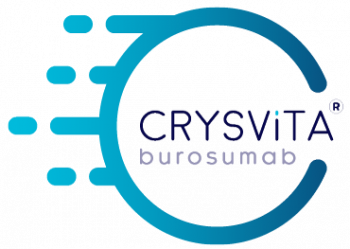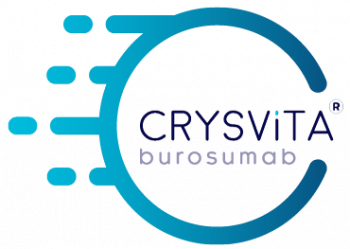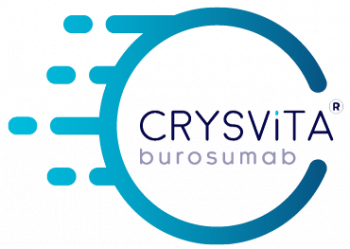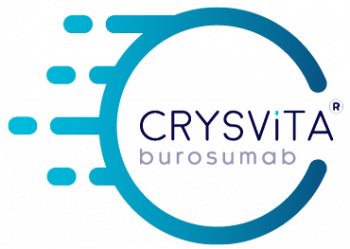CRYSVITA® (burosumab) is the first and only disease-modifying biologic treatment that targets the pathophysiology of XLH¹
FGF23 and XLH
CRYSVITA® is a fully human monoclonal antibody (IgG1) that binds to and inhibits excess FGF23 activity1
Excess levels of FGF23 in XLH lead to:2
- Decreased renal phosphate reabsorption, which increases urinary phosphate excretion
- Decreased active vitamin D (1,25[OH]2D) production, which reduces intestinal phosphate absorption
The effects of the excess FGF23 leads to chronic hypophosphataemia resulting in impaired bone mineralisation, leading to rickets in children with XLH and osteomalacia in adults with XLH.2
CRYSVITA® mode of action
CRYSVITA® is the first and only disease-modifying biologic treatment that targets the pathophysiology of XLH, thereby restoring phosphate homeostasis1
Conventional therapy for XLH
Conventional therapy for XLH is based on oral phosphate and active vitamin D supplementation,3 but is associated with variable improvement in clinical features and may lead to adverse effects, such as hyperparathyroidism and nephrocalcinosis.5 Conventional therapy does not address the excess levels of FGF23 that underlie the pathophysiology of XLH.3
Taking oral phosphate and active vitamin D supplements has been associated with increases in FGF23 levels, which may diminish their therapeutic effect in XLH.3
Conventional therapy is also associated with low compliance and the multiple daily dosing regimen places a significant burden on patients with XLH and their carers.2,5

Conventional therapy may be poorly tolerated, with many patients experiencing gastrointestinal side-effects such as abdominal pain, diarrhoea and nausea.2,5,6 Potential adverse effects of conventional therapy include nephrocalcinosis and hyperparathyroidism.3
Phosphate homeostasis
CRYSVITA® restores phosphate homeostasis and improves bone mineralisation in people with XLH, by inhibiting excess FGF23 activity1,6,7
Based on pre-clinical studies, CRYSVITA® helps restore phosphate homeostasis by:1,8
- Decreasing renal phosphate excretion by increasing expression of sodium phosphate cotransporters (NaPi-2a/NaPi-2c)
- Increasing intestinal phosphate absorption by increasing 1-α hydroxylase levels and active vitamin D production
CRYSVITA® restores phosphate homeostasis in people with XLH6,7,9
1. Portale AA, et al. Calcif Tissue Int. 2019;105(3):271-84. 2. Linglart A, et al. Endocr Connect. 2014;3:R13–R30. 3. Beck-Nielsen SS, et al. Orphanet J Rare Dis. 2019;14:58. 4. Imel EA, et al. Br J Clin Pharmacol. 2019;85:1188–98. 5. Imel EA, et al. Lancet. 2019;393:2416–27. 6. Carpenter, TO et al. J Bone Miner Res. 2011;26:1381–88. 7. Insogna KL, et al. J Bone Miner Res. 2019;34:2183–91. 8. Hernando, N and Wagner, C. Compr Physiol. 2018;8:1065–90. 9. Whyte MP et al. Lancet Diabetes Endocrinol. 2019 Mar;7(3):189-199
